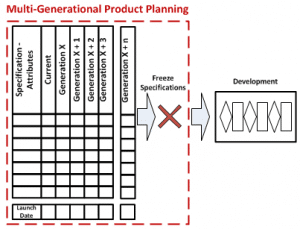What is MGPP?
Multi-Generational Product Planning
And why every product manager should learn how to use MGPP to improve product line strategies and development efforts.
MGPP stands for Multi-Generational Product Plan. Some practitioners replace the word “product” with the word “project.” And some may change “plan” to “planning,” switching the acronym from a noun to a verb.
![]()
WHAT IS MULTI-GENERATIONAL PRODUCT PLANNING
MGPP is an approach managers use to set the features to be developed in a product. It defines a development project’s scope.
Prevent Scope Creep
The approach also requires teams to compile, or put into reserve, those features not included in a new product project’s “planned” scope. The team then analyzes all of the unused features to determine if these features should be put into future products, or, as we say, the next “generation” of the product. This approach to controlling features helps teams to avoid project creep, and the negative consequences of a run away scope.
Multi-generational planning has two significant benefits most teams wish to gain. And both of the benefits result from avoiding scope creep. First, it helps teams to develop products faster. And second, avoiding scope creep helps prevent cost overruns.
MGPP and MVP
It is proper to think of a “minimum viable product” (or MVP) as the first potential generation of a product. But even though it may be possible to make the MVP as the first generation, it may not be wise. Often, managers find that adding select product features beyond the MVP may speed market diffusion and fend off competitors.
MGPP and Platform-Levers
It is not just for individual products. You’ll also see Product line teams apply Multi-generational planning to platform-levers, these are core designs or assets that enable leverage across multiple product. In this way, generational planning for platform-levers greatly affects the product line and its advancement with technology and market changes. Most high-tech companies use Multi-generational planning in orchestrating the platform-levers within their product lines.
And its quite helpful to know that multi-generational planning can help teams when they manage their product line as a system. It makes understanding and planning the interplay between product line system parts and forces much easier. It’s because it’s an extension of existing parts, and doesn’t require scrapping everything and starting over from scratch.
Agile Backlogs
The software and systems product worlds often use agile techniques to carry out projects. A fundamental principle is to streamline your focus by creating a backlog of work like software fixes, UX refinements, and new features.
You’ll see Agile backlogs instead of multi-generational plans in small and medium-sized companies where a single product is the product line. And backlogs may be in play at larger firms but within distinct project-level subsets of the product line roadmap and plan.
But MGPP comes into play at a higher level. Consider the Apple iPhone. No doubt Apple engineers work off backlogs for products already placed in the market. But advancements on chipsets, camera features, and screens are not Agile backlog items. Instead, teams layout these features in multi-generational plans.
Adding MGPP Skills
Carrying out multi-generational planning demands more than learning a method or technique. It needs companies to build the discipline to step back from making the best possible product or platform-lever. This may be counter cultural within some companies.
Instead, managers must have the discipline to say “no” to potential features. And they must do this even when feature requests have strong political backing.
The approach is not to kill the extra features. Instead, the approach is to move the extra features to future product generations. But to do this job, managers must clearly understand MGPP and the product line’s strategy.
Companies skilled in MGPP are better able to carry out smart product line strategy moves. The goal is to deliver, over time, greater customer benefits, to drive improved free cash-flow, and to fend off competition.


